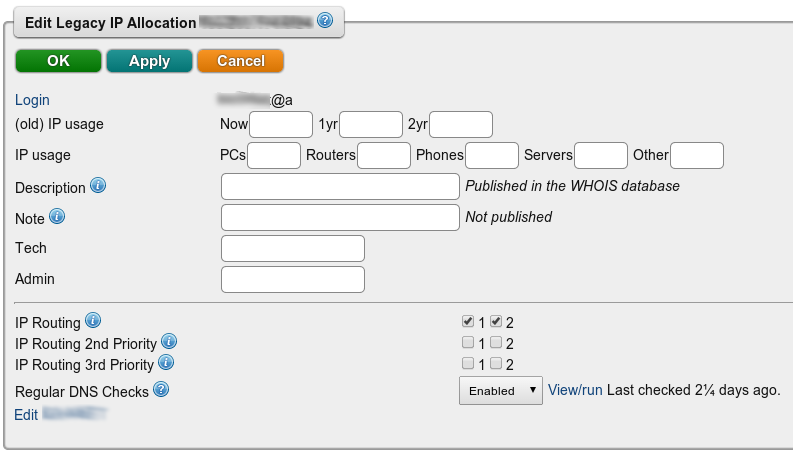Bonding IP Settings: Difference between revisions
Created page with "==IP addressing and routing== Our control pages allow you to adjust the IP routing on your lines. You can have multiple IP addresses on a login, and each can be set for routin..." |
|||
| (2 intermediate revisions by the same user not shown) | |||
| Line 1: | Line 1: | ||
<indicator name="Front">[[File:Menu-bonding.svg|link=:Category:Bonding|30px|Back up to the Bonding Page]]</indicator> |
|||
==IP addressing and routing== |
==IP addressing and routing== |
||
Our control pages allow you to adjust the IP routing on your lines. You can have multiple IP addresses on a login, and each can be set for routing to one or more lines. You can set each IP address block separately and can define backup routing. |
Our control pages allow you to adjust the IP routing on your lines. You can have multiple IP addresses on a login, and each can be set for routing to one or more lines. You can set each IP address block separately and can define backup routing. |
||
*For more information see the [[IP Routing]] page. |
|||
[[File:Control-pages-editip4.png|none|frame|IPv4 Routing information, selecting multiple lines for bonding]] |
|||
The recommended set up is to use a FireBrick and multiple PPPoE modems or bridges. The FireBrick would have one WAN address over all of the lines, and either public Legacy IPv4 addresses on the LAN, or private address and NAT on the FireBrick. In either case you can have public IPv6 addresses on the LAN and still handle bonding down and up on multiple lines. |
The recommended set up is to use a FireBrick and multiple PPPoE modems or bridges. The FireBrick would have one WAN address over all of the lines, and either public Legacy IPv4 addresses on the LAN, or private address and NAT on the FireBrick. In either case you can have public IPv6 addresses on the LAN and still handle bonding down and up on multiple lines. |
||
| Line 6: | Line 11: | ||
The alternative if to use separate routers. These would normally share a /29 interlink subnet and connect to some firewall or router within you network, routing a static IP block to that router. The interlink address block could be private IPv4 addresses but you do not want NAT or fire-walling on the external routers even in that case as it will not handle the bonding. In general using the FireBrick and PPPoE is simpler and more flexible. |
The alternative if to use separate routers. These would normally share a /29 interlink subnet and connect to some firewall or router within you network, routing a static IP block to that router. The interlink address block could be private IPv4 addresses but you do not want NAT or fire-walling on the external routers even in that case as it will not handle the bonding. In general using the FireBrick and PPPoE is simpler and more flexible. |
||
For more information see the [[IP Routing]] page. |
|||
Latest revision as of 09:26, 19 March 2018
IP addressing and routing
Our control pages allow you to adjust the IP routing on your lines. You can have multiple IP addresses on a login, and each can be set for routing to one or more lines. You can set each IP address block separately and can define backup routing.
- For more information see the IP Routing page.

The recommended set up is to use a FireBrick and multiple PPPoE modems or bridges. The FireBrick would have one WAN address over all of the lines, and either public Legacy IPv4 addresses on the LAN, or private address and NAT on the FireBrick. In either case you can have public IPv6 addresses on the LAN and still handle bonding down and up on multiple lines.
The alternative if to use separate routers. These would normally share a /29 interlink subnet and connect to some firewall or router within you network, routing a static IP block to that router. The interlink address block could be private IPv4 addresses but you do not want NAT or fire-walling on the external routers even in that case as it will not handle the bonding. In general using the FireBrick and PPPoE is simpler and more flexible.
For more information see the IP Routing page.